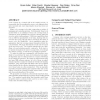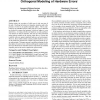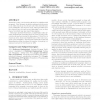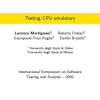ISSTA
2009
ACM
14 years 6 months ago
2009
ACM
Code coverage is a common aid in the testing process. It is generally used for marking the source code segments that were executed and, more importantly, those that were not execu...
ISSTA
2009
ACM
14 years 6 months ago
2009
ACM
During testing, the execution of valid cases is only one part of the task. Checking the behavior in boundary situations and in the presence of errors is an equally important subje...
ISSTA
2009
ACM
14 years 6 months ago
2009
ACM
This paper explores an approach to improving the practical usability of static verification tools for debugging synchronization idioms. Synchronization idioms such as mutual excl...
ISSTA
2009
ACM
14 years 6 months ago
2009
ACM
ISSTA
2009
ACM
14 years 6 months ago
2009
ACM
Bug localization has attracted a lot of attention recently. Most existing methods focus on pinpointing a single statement or function call which is very likely to contain bugs. Al...
ISSTA
2009
ACM
14 years 6 months ago
2009
ACM
Atomicity is a key correctness specification for multithreaded programs. Prior dynamic atomicity analyses include precise tools, which report an error if and only if the observed...
ISSTA
2009
ACM
14 years 6 months ago
2009
ACM
ISSTA
2009
ACM
14 years 6 months ago
2009
ACM
Many automatic testing, analysis, and verification techniques for programs can be effectively reduced to a constraint-generation phase followed by a constraint-solving phase. Th...
ISSTA
2009
ACM
14 years 6 months ago
2009
ACM
Program differencing is a common means of software debugging. Although many differencing algorithms have been proposed for procedural and object-oriented languages like C and Ja...
ISSTA
2009
ACM
14 years 6 months ago
2009
ACM
This paper presents techniques for analyzing channel contract specifications in Microsoft Research’s Singularity operating system. A channel contract is a state machine that sp...




